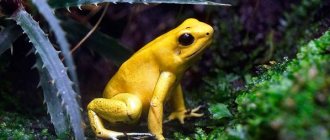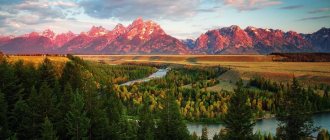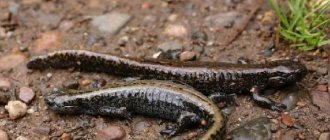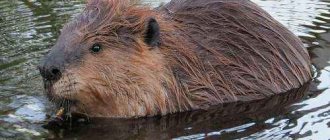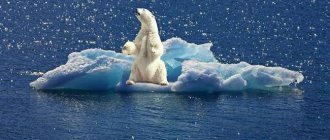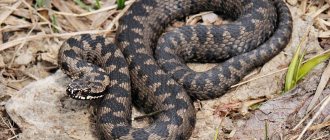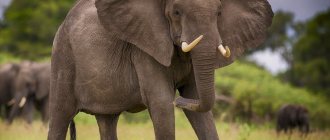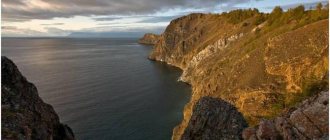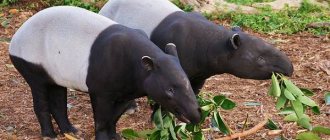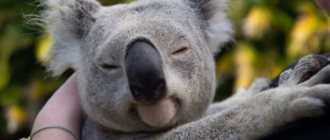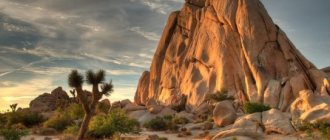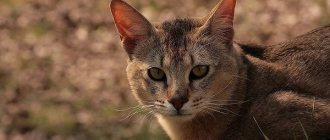The north of the American continent is covered with vast coniferous forests. This is the habitat of animals that are similar to Asian species. From Canada and almost to the border with Mexico, the Rocky Mountains stretch along the entire continent. The natural conditions on both sides of the mountains are noticeably different from each other. The narrow coastline in the west is a fairly complex and diverse ecosystem.
Air masses passing from the Pacific Ocean lose a significant amount of moisture over the Rocky Mountains, and it is for this reason that very little precipitation falls on the eastern side. Even before the middle of the 19th century, herds of bison and packs of wolves roamed peacefully across the endless dry expanses of the local prairies in the center of the North American continent. Closer to the southeast coast the climate begins to become wetter. The Gulf Coast and Florida are quite humid and hot.
Bighorn sheep (bighorn sheep)
photo: Buzz Andersen
Bighorn sheep live on the Great Plain and in the mountains of the North American continent . Its skin is brown with a white marking on the back. Males have large and heavy horns, twisted in a spiral, but females have much lighter and smaller ones. Females and males of bighorn sheep live separately in the summer, only coming together to mate in the fall. At this time, the males organize tournaments among themselves, clashing with their massive horns.
Sharp-crested tit
The sharp-crested tit is a small, grey-silver songbird, recognizable by its crest of gray feathers on its head, as well as its large black eyes and rufous flanks. Sharp-crested tits are known for their fashion sense, using the shed skin of snakes and in some cases even plucking the fur from living dogs to make their nest. Unusually, sharp-crested tit chicks can linger in the parent's nest throughout the year, helping their parents with the next offspring.
red lynx
This rather agile feline predator with a short tail is a close relative of the common lynx, which is common in Asia, Europe and Canada. Although the red lynx's lifestyle and habits are similar to its relatives, it prefers to live in warmer areas of North America. During the day, she hides in rock crevices, tree hollows, and sometimes even behind waterfalls.
Canadian beaver
The Canadian beaver is one of two living species of the beaver family, the other being the common beaver, or river beaver, found in Europe and Asia, and is also the national animal of Canada. After the capybara, they are the second largest rodent in the world, and can reach a weight of over 30 kg. Canadian beavers are stocky animals with compact bodies and short legs. Their feet are webbed, and their tails are wide, flat and covered with scales. To protect themselves from predators or adverse weather conditions, the Canadian beaver constantly builds dams from sticks, leaves, mud and branches.
Caribou
photo: Paul Nicol
The north of the continent is home to caribou, wild deer that are relatives of the domesticated reindeer of the Eurasian continent. They are larger than their relatives from Eurasia, and have smaller horns. Most caribou spend the summer far north in the tundra, and in the fall, gathered in large herds, migrate south to spend the winter in the forests. They are excellent swimmers and overcome any water obstacles with ease.
Reserves
To preserve the exceptional nature of North America, national parks and reserves are created.
Yellowstone Preserve
The oldest nature reserve in the world was opened in 1842. It is located on the territory of three states at once, its area is 898 thousand hectares. It is on the UNESCO heritage list. It is famous for its unique natural beauty, unique geysers, and hot springs.
Rangel St. Elias
The largest nature reserve in the USA. Previously, minerals were mined here, but now you can go hiking and camp here. The park is located near volcanoes, around which there are many hot and mud springs.
Mount Robson
This park is located in British Columbia. The highest point is Mount Robson, around which the reserve is located. Amazing landscapes, rare species of animals, glaciers, canyons are a real delight for tourists.
Coyote (steppe wolf)
photo:matt knotah
The coyote is one of the most common mammals in the United States. Their habitat is the desert, vast prairies, shady forests and even snowy tundra. Coyotes, like their relatives wolves, feed mainly on meat, although they do not disdain carrion, as well as bird eggs, berries and fruits. Coyotes live in packs, the size of which can be very different, but if quite large prey appears in their habitat, then they gather in a large group to hunt. If the main food is rodents, then coyotes have to live in families.
Amphibians (amphibians)
Legless amphibians
Legless amphibians are tropical amphibians that resemble large worms or slithering snakes. They have no limbs, and sometimes it is difficult to determine where the head is and where the tail is. Their skin is smooth and shiny, gray, brown, black, orange or yellow. Some species have tiny, scales.
Most individuals live in tunnels underground. The hard, thick, pointed skull helps these amphibians dig in soft mud. Due to their underground lifestyle, they have a low need to see or hear. Thus, their eyes are tiny in some species or hidden under the skin or skull, while in other species they look like tubercles.
Representatives of the following families live in South America: Rhinatrematidae, Caeciliidae, Typhlonectidae, Siphonopidae, Dermophiidae.
Anurans
Darter frogs are the colorful and venomous members of the anuran order of South America.
There is a huge variety of anuran species, each adapted to life in its own unique habitat, be it steep mountain slopes, scorching deserts or tropical forests. Depending on the species, they can be found in water, on the ground or in trees, and come in a variety of sizes and colors.
Dart frogs are a family of poisonous frogs, from the class Tailless. They are known for their vibrant colors, which include the following color combinations: red and black, yellow and green, orange and silver, blue and yellow, green and black, pink and silver. Their bright coloring is not an indicator of beauty, but a warning that they are poisonous.
They are tiny, terrestrial, diurnal frogs that live primarily in leaf litter on the forest floor, but some species live high in forest canopies and may never come down. Their homeland is rain forests near rivers or ponds in Central and South America.
Dart frog venom can cause severe swelling, nausea, and muscle paralysis. If a predator survives after eating such a frog, it will remember its mistake and will not try to dine on something similar in the future. However, there is one snake, Leimadophis epinephelus, that is immune to frog venom and feeds on these small creatures.
Grizzly
photo: Tim Melling
The grizzly bear is a North American bear that sometimes reaches gigantic sizes. When a grizzly bear rises on its hind legs, its height is sometimes up to 3 meters, and its weight is about 300 kilograms. Its diet includes fish, small animals and plants. In one day, a bear usually eats up to 12 kilograms of food. In winter, the grizzly bear hibernates for six months, thereby going without water and food.
Rare animals
America is a very unique continent and almost all the animals living here are rare and distinctive in themselves, since for a long time they had to evolve in conditions of geographic isolation.
Some species are currently endangered; most often, animals are endangered by humans, and this list is constantly growing.
Uakari monkey
It is the closest relative of the saki monkey. These monkeys have a very distinctive appearance: they have a red face and a bald forehead. In addition, the uakari constantly has a very sad and thoughtful expression on his face, as a result of which he resembles a certain wise old man. But the appearance of the monkey is very deceptive: uakari have a very cheerful disposition and are extremely friendly. However, if the animal is nervous, it begins to loudly smack its lips or strongly swing the branch on which it sits. Uakari is a small monkey: the average height of an adult is about 50 centimeters and weight is 3.5 kilograms.
The animal lives in humid equatorial forests.
Vicuna
This ungulate, native to the Andes, is a member of the camel family. The ancient mountain dwellers considered it a sacred animal and worshiped it. Later, the vicuñas began to be exterminated by the Spaniards who arrived on the continent - they used the softest wool of the animal for the needs of their nobles.
Vicuña is the smallest representative of her group, her weight does not exceed 50 kilograms. The body of the animal is covered with red soft wool, which is of very high quality due to the thinness of the hair.
Pampas deer
The representative of the artiodactyl order is an inhabitant of savannas.
Currently, hunting this animal is prohibited by law, but the ban is constantly violated, as a result of which this species is in danger of complete extinction. The animal is very friendly and harmless; it feeds on herbs, shrubs and berries. The deer's fur changes color throughout the year: in winter it is light gray, in summer it acquires a red-brown tint. The animal is very graceful: its weight is about 40 kilograms, its body length is about 150 centimeters.
Pudu deer
Pudu deer lives on the slopes of the Andes and on the Chilean islands in the steppe zone.
It has very little in common with an ordinary deer: its weight barely reaches 10 kilograms and its height is only about 35 centimeters. The baby has a squat build, short horns and brown fur with white spots.
Andean condor
A very large bird of prey (its weight can reach 15 kilograms with a height of about 130 centimeters). It feeds exclusively on carrion, chicks and eggs. The bird's wingspan can reach three meters.
Condors were actively exterminated because they were wrongly accused of killing livestock, but these birds are useful for nature, as they are its orderlies. Currently, the condor can only be found in nature reserves.
Buffalo
photo: trickofthelight
Bison, or as some people also call them, bison , belong to the same family as cows, however, they are much larger. The weight of an adult male bison can reach up to 900 kilograms. During the winter molting period, they roll on the ground to get rid of old fur. Once upon a time, huge herds of these powerful animals roamed the vast expanses of the prairies of North America, however, now there are not so many of them left.
Fishes of North America
Bycheryl
This is a North American stingray. Its wing fins are considered a delicacy. Therefore, the bullheads are mercilessly exterminated. The number of the species is declining.
The bulltail can grow up to 2 meters in length, but often does not exceed one and a half. Fish stay in schools near reefs. Accordingly, the animal is marine and is found off the coasts of North America, mainly the eastern ones.
Rainbow trout
A typically American fish, it was introduced into European waters in the last century. The second name of the animal is mykizha. That's what the Indians called the fish. They have been observing trout in western North America for centuries.
Rainbow trout is a salmon fish, found in clean, fresh and cool waters. There, mykizha reaches a length of 50 centimeters. The maximum weight of the fish is 1.5 kilograms.
Largemouth Bass
Another Native American. It was also exported outside the continent in the 20th century. The name of the fish is due to the size of its mouth. Its edges go behind the animal's eyes. It lives in fresh water bodies. They should be clean, without fast flow.
Largemouth bass are large, reaching a meter in length and weighing up to 10 kilograms. The color of the fish is gray-green. The body, atypically for a perch, is elongated and laterally compressed. Therefore, the animal is compared to trout, called trout perch. However, there is no relationship between fish.
Muskinong
This is a North American pike. It is also called giant. It grows to 2 meters in length, weighing 35 kilos. Externally, the fish is similar to an ordinary pike, but the blades of the caudal fin are pointed rather than rounded. Even in the muskeg, the bottom of the gill covers is devoid of scales and there are more than 7 sensory points on the lower jaw.
Muskinog loves clean, cool, sluggish bodies of water. Therefore, North American pike is found in rivers, lakes and floods of large rivers.
Lightfin zander
Because of its color it is also called yellow pike perch. The sides of the fish are golden or olive brown. The American weighs less than an ordinary pike perch. The weight of overseas fish does not exceed 3 kilograms. Females are larger than males. Biologists call this division sexual dimorphism.
Like the common pike perch, the lightfin loves clean, cool and deep waters. They must be saturated with oxygen.
Wolverine
Wolverine is the largest representative of the mustelid family and resembles a bear cub in its appearance. This is a rather bloodthirsty animal with a huge appetite. As a rule, the wolverine feeds on carrion, but can often hunt live animals. The wolverine's habitat is the taiga, forest-tundra and partly tundra of North America and the Eurasian continent.
Arachnids
Spiders
Spiders have a bad rap and are feared by many people. But only a few species are dangerous to humans, and they bite if they sense danger. Spiders are not classified as insects due to certain anatomical differences. For example, spiders have two main body parts: the anterior part is called the cephalothorax, and the posterior part is the undivided abdomen; insects have three body parts: head, chest and belly. Spiders have eight legs, while insects have six.
Tarantula spiders from the family Theraphosidae are among the largest spiders in the world. They are found not only in South America, but also on other continents with the exception of Antarctica. Their diet is quite varied and, contrary to their name, they do not always feed on bird meat. All species have poison, but in varying amounts. The poison is not fatal for an adult and healthy person, which cannot be said about small children and people sensitive to it.
Scorpios
Scorpions belong to the order of arthropods. They prefer hot climates and lead a terrestrial lifestyle. There are about 1,750 species of scorpions, but only 50 are dangerous to humans due to their venom. Six pairs of limbs are attached to the cephalothorax, four of which are intended for movement.
These are viviparous animals; they undergo a life cycle without metamorphosis. Scorpions are nocturnal and can run fast. The diet consists of insects and arachnids. The venom of most species is harmless, but some are dangerous and can cause death, especially in children.
Scorpions from the following families are found in South America: Buthidae, Chactidae, Scorpionidae, Euscorpidae, Hemiscorpiidae, Bothriuridae.
Raccoon
photo:Martien Uiterweerd
the striped raccoon its name . He was so nicknamed for his rather amusing habit of rinsing various objects in water, and most often rinsing the food he had obtained. A raccoon can stand in the water for a long time to catch fish, frogs or crayfish. It is distinguished from the rest of its relatives by the black color of the fur around its eyes, which is very reminiscent of glasses. The raccoon's habitat is North America, from the southern provinces of Canada to the Isthmus of Panama.
The cold climate is not scary not only for large animals, it also does not frighten the birds of North America - brent geese, snow geese, snowy owls and tundra partridges . The peculiar climate attracted some marine animals, such as the walrus, seal, beluga whale and narwhal . is found in cold waters . Fresh water bodies in the north abound with a variety of fish: whitefish, trout and grayling .
Common Ruby-throated Hummingbird
Common (ruby-throated, ruby-throated) hummingbirds are tiny birds, weighing about 4 grams. Both sexes have golden-green plumage along their backs and light gray feathers on their bellies. The necks of these birds are glossy red, which is how they get their name, ruby-throated or ruby-throated hummingbird. The ruby-throated hummingbird's wing beat frequency is up to 50 beats per second, which allows them to soar and even fly in the opposite direction if necessary.
American catfish
The American or dwarf catfish (Ameiurus nebulosus) is a fish of the family Ictaluridae that is widespread in North America and was originally described as Pimelodus nebulosus by Charles Alexandre Lesure in 1819. The American catfish is important as a clan symbol of the Ojibway group of Native Americans. According to their beliefs, the American catfish is one of six creatures that emerged from the sea to form the original clans.
The southeast of North America is inhabited by animals and birds of the tropics. Pelicans, flamingos, parrots and hummingbirds, alligators and snapping turtles have chosen this area of North America. Among amphibians the bullfrog , its length reaches 20 cm.
Borders
On the world map, America is indicated by the following points:
The extreme points of North America have the following coordinates:
- northern point - Cape Murchison, 71° 50′ N. w. 94° 45′ W d.;
- southern point - Cape Mariato, 7° 12′ N. w. 80° 52′ W d.;
- western point - Cape Prince of Wales, 65° 35′ N. w. 168° 05′ W d.;
- eastern point - Cape St. Charles, 52° 24′ N. w. 55° 40′ W d.
The extreme points of South America have the following coordinates:
- northern - Cape Gallinas 12° 27′ N. w. 71° 39′ W d.;
- southern (mainland) - Cape Froward, 53° 54′ S. w. 71° 18′ W d.;
- southern (island) - Diego Ramirez, 56° 30′ S. w. 68°43′ W d.;
- western - Cape Parinhas, 4° 40′ S. w. 81° 20′ W d.;
- eastern - Cape Cabo Branco, 7° 10′ S. w. 34° 47′ W d.
Records
The highest point in North America is Mount Denali (called McKinley until 2015) - 6190 m, the lowest is Death Valley - 86 meters below sea level.
The highest point in South America is Mount Aconcagua, its height is 6962 m. The lowest point is Peninsula Valdes in Argentina - 40 meters below sea level.
Mount Aconcagua
snapping turtle
photo: Francesco D'Aleo
Although the snapping turtle (Chelydra serpentina) prefers shallow water, it is capable of diving to depths of 2-3 meters or more. Female turtles can undertake significant migrations to find a suitable nesting site, with the longest recorded round trip migration being 16 km.
It is impossible not to mention some of the most dangerous animals in North America , which at times annoy humans.
Brown bear
The brown bear is one of the largest and most powerful land predators in North America. These bears are equipped with non-retractable claws that are used primarily for digging and also provide good traction when running. Despite their body weight of over 500 kg, these animals reach speeds of up to 50 km per hour. The name of the animal speaks for itself; brown bears have dark brown or yellowish-brown fur.
Arizona snaketooth
The Arizona common lizard (Helodermasu spectum) is the only venomous lizard among North American animals that is actually not as scary as they say. This “monster” weighs only a couple of kilograms and since 1939, there has been no confirmed information that a person has died due to the Arizona serpentine tooth. Most of the lizard's habitat is in western and southern Arizona, south to southern Sonora in Mexico, although populations also occur in limited areas of California, Nevada, Utah and New Mexico.
Insects and arthropods of North America
Arizona tree scorpion
The eight-centimeter creature stings so much that victims compare the damage to an electric shock. By injecting neurotoxic poison, the scorpion condemns the victim to pain, vomiting, diarrhea, and numbness. Death occurs in rare cases, mainly from bites of children and the elderly.
The tree scorpion lives in the south of the continent. From the name of the animal it is clear that it loves to climb trunks. Most of the remaining 59 species of North American scorpions live in deserts and pose no danger to humans. Toxins from hairy and stripedtal scorpions, for example, only cause allergic reactions.
Bodushka buffalo
A bright green insect about 8 millimeters long. The animal is flattened laterally and elongated vertically. The elytra protrude above the head, giving it an angular appearance. This outline resembles the face of a bison. There are transparent wings on the sides of the bodushka's body.
The bodushka harms trees by making holes in them in which it lays eggs.
Black Widow
This spider is indeed black, but there is a red spot on its abdomen. The animal is poisonous. Five hundredths of a gram of toxin kills a person.
Along with the black widow, the recluse and the wanderer are dangerous among the spiders of North America. The latter's venom is carnivorous. The affected tissue is literally corroded. The picture is creepy, but the spider’s toxin is not fatal, and the spider itself has a peaceful disposition and rarely attacks people.
Widowmaker's venom dissolves prey tissue, allowing the spider to suck out food like soup
Cicada 17 year old
The insect is bright, colored brown and orange. The eyes and legs of the animal are red. The body length of the cicada is 1-1.5 centimeters, but the wings are more elongated.
The seventeen-year cicada is named due to its development cycle. It starts with the larva. From the first days of its existence until the death of the old cicada, 17 years pass.
Monarch
This is a butterfly. Its orange wings with brown streaks are surrounded by a black border with white dots. The body is also dark with light markings.
The monarch feeds on pollen. However, the butterfly caterpillar eats the milkweed. This plant is toxic. The caterpillar's stomach has adapted to the poison, similar to the digestive system of koalas eating toxic eucalyptus. The insect's body is literally soaked in milkweed extract. Therefore, birds, frogs, and lizards do not hunt the monarch. They know that the butterfly is poisoned.
Pictured is a monarch butterfly caterpillar
Aquatic Cottonmouth
photo: Ron Kernan
It prefers wetlands, but is also found on land in vegetation and under logs and branches . An aggressive, venomous snake that affects residents of the United States every year. The consequences of its bite are very painful, but deaths are extremely rare. The water muzzle is a carnivore, feeding primarily on mammals and fish. Other prey includes frogs, turtles, snakes, eggs, insects, carrion and birds.
This is only a short list of the fauna of North America , since it would take quite a lot of time to list and describe all its diversity.
Mammals of North America
Cougar
Otherwise - a cougar or mountain lion. The cougar is found on the west coast of America, all the way to Canada. The predator kills prey by sinking its fangs between the cervical vertebrae. The spinal cord is damaged. Prey is paralyzed.
The method also works with people. There is approximately one fatal cougar attack on Americans per year. Animal aggression is associated with the settlement of wild territories, or due to the protection of animals, for example, during hunting.
Cougars are animals of North America that are excellent at climbing trees, hearing footsteps at a distance of several kilometers, and reaching a speed of 75 kilometers per hour.
Most of the puma's body is made up of muscles, allowing it to run quickly and overcome the most impassable terrain.
polar bear
Living on the northern tip of the continent, it gains a mass of 700 kilograms. This is the maximum for predators living on the planet. Climate change is pushing giants towards human habitations. Glaciers are melting.
Polar bears are exhausted, crossing the expanses of water, and have difficulty finding food in the remaining patches of snow-covered lands. Therefore, the number of polar clubfoot is declining. At the same time, contacts between animals and people are becoming more frequent.
During the 20th century, only 5 cases of polar bear attacks on people were recorded. More often, bipeds become aggressors. Poachers shoot bears for fur and meat.
American beaver
It is the second largest among rodents and the first among beavers. In addition to the American one, there is also a European subspecies. As for the leader in terms of mass among rodents, it is the capybara. The African capybara weighs 30-33 kilograms. The mass of the American beaver is 27 kilos.
The American beaver is the unofficial symbol of Canada. The animal differs from the European rodent in its enlarged anal glands, shortened muzzle and triangular shape of the nostrils.
Black bear
Otherwise called baribal. There are 200 thousand individuals in the population. Therefore, baribal is listed in the Red Book. You can see the rare clubfoot at altitudes from 900 to 3 thousand meters above sea level. In other words, baribals choose mountainous territories, sharing their habitat with the brown bear.
The baribal has a medium size, a pointed muzzle, high paws, elongated claws, and short hair. There is no anterior humeral hump. This is the main difference from the grizzly bear.
American Moose
It is the largest in the deer family. The height of the ungulate at the withers reaches 220 centimeters. The body length of an American moose is 3 meters. The maximum body weight of the animal is 600 kilograms.
American moose also differ from other moose in their long rostrum. This is the preocular section of the skull. The ungulate also has wide branches of horns with a prominent anterior process. It is also branched.
White-tailed deer
In America, this graceful animal causes 200 human deaths every year. Deer are careless when crossing highways. Not only ungulates die, but also people in cars.
Every year, approximately 100,000 deer are killed on American roads. Therefore, the US State Traffic Safety Inspectorate rules contain the concept of DVC. Stands for "deer-vehicle collision."
Long-tailed armadillo
the animal world of North America can “boast” of it . The half-meter mammal weighs about 7 kilograms. In moments of danger, the armadillo curls up, becoming like a round stone. Vulnerable areas are hidden inside the armored cobblestone.
Like deer, armadillos are careless when crossing roads and die under the wheels of cars. Collisions are frequent at night, since the relict animals are inactive during the day. At night, armadillos go out in search of food. They are served by insects.
Coyote
The coyote is about a third smaller than a wolf, thin-boned, and has long hair. The latter is almost white on the belly of the predator. The top of the coyote's body is gray with black spots.
Unlike wolves, coyotes are often mistaken for companions by farmers. Predators destroy rodents in the fields without preying on livestock. True, a coyote can ruin a chicken coop. Otherwise, the beast helps farmers more than harms them.
Melvin Island Wolf
It is also called Arctic. The predator lives on islands off the northern coast of America. The animal is a subspecies of the common wolf, but is colored white and smaller.
The weight of the male reaches a maximum of 45 kilograms. In addition, the island wolf has small ears. If their area were standard, a lot of heat would evaporate. In Arctic conditions this is an unaffordable luxury.
Animals living in North America create small flocks. In ordinary wolves, 15-30 individuals unite. Melvin's predators live in groups of 5-10. The leader of the pack is the largest male.
American bison
A two-meter giant weighing 1.5 tons. In America it is the largest land animal. Outwardly, it is similar to the black African buffalo, but has a brown color and is less aggressive.
Considering the size of the bison, it is agile and reaches a speed of 60 kilometers per hour. The once common ungulate is now listed in the Red Book.
musk ox
Otherwise it is called musk ox. Another large and massive ungulate of the North American continent. The animal has a large head, short neck, wide body with long hair. It hangs down the sides of the bull. Its horns are also located on the sides, touching the cheeks, moving away from them to the sides.
In the photo, animals of North America often stand among the snow. Musk oxen are found in the north of the continent. In order not to drown in the snow, the animals acquired wide hooves. They provide a solid area of contact with the cover. In addition, the wide hooves of musk oxen effectively dig snowdrifts. Under them, animals find food in the form of plants.
Skunk
Not found outside of North and South America. The animal's glands produce the odorous ethyl mercaptan. Two billionths of this substance is enough for a person to smell it. The externally odorous substance is a yellow oily liquid.
Skunk secretions are difficult to wash off clothing and the body. Usually, those caught under the animal's stream do not risk appearing in society for 2-3 days.
American ferret
Refers to mustelids. In 1987, the American ferret was declared extinct. The discovery of single individuals and genetic experiments made it possible to restore the species. This created new populations in Dakota and Arizona.
By 2018, almost a thousand individuals of the American ferret were counted in the western United States. It is distinguished from the usual by the black coloration of its legs.
Porcupin
This is a rodent. It is large, reaching 86 centimeters in length, and lives in trees. Locals call the animal the needletail.
In Russia, the porcupine is called the American porcupine. Its hairs are jagged. This is a defense mechanism. Porcupine "needles" pierce enemies, remaining in their bodies. In the body of a rodent, the “weapon” is loosely attached so that it can easily jump out if necessary.
Long and tenacious claws help the porcupina climb trees. However, you can meet a rodent on land and even in water. Porcupine is an excellent swimmer.
prairie dog
Has nothing to do with dogs. This is a rodent of the squirrel family. Externally, the animal looks like a gopher and lives in burrows. The rodent is called a dog because it makes barking sounds.
Prairie dogs are animals of the North American steppes . Most of the population lives in the west of the continent. There was a rodent extermination campaign going on there. They damaged farmers' fields. Therefore, by 2018, only 2% of the previously counted 100 million individuals remained. Now prairie dogs are rare animals in North America .
Pudu deer
When looking at this cute creature, one would hardly think that modern classification places it in the Olenev family! Could there be anything in common between this amazing animal of South America, distinguished by its tiny size, and the large, stately artiodactyls that gallop at full speed across the steppes, forests and plains?
It turns out that zoology still considers the puda and its larger relatives as one category of mammals. The small creature is characterized by a body length of 80-93 cm, a height of 30 to 40 cm and a weight of 7 to 10 kg. The head is crowned with short horns, which can grow a maximum of 10 cm. Pudus live exclusively in the lands of Chile, Western Argentina, the islands of the Chilean coast, in particular Chiloe, and in the mountain valleys of the Andes.
Despite their small size, pudus are distinguished by both emotional and physical endurance. The fact is that every day these deer have to fight for their right to exist, because, firstly, they are a tasty prey for a whole host of dangerous predators, and, secondly, they are considered valuable for poachers who sell them like exotic pets. Adding to this mass deforestation, you can get a completely bleak picture of the life of the pudu. And yet they try to preserve their own population, in which the defense mechanisms developed over the years of evolution are especially helpful. For example, pudus can go without water for a long time, and also climb inclined trees to escape danger.
